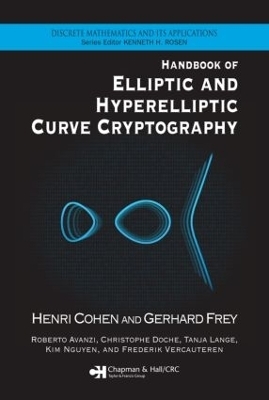
Handbook of Elliptic and Hyperelliptic Curve Cryptography
Seiten
2005
Chapman & Hall/CRC (Verlag)
978-1-58488-518-4 (ISBN)
Chapman & Hall/CRC (Verlag)
978-1-58488-518-4 (ISBN)
Zu diesem Artikel existiert eine Nachauflage
Introduces the theory and algorithms involved in curve-based cryptography. This book provides ready-to-implement algorithms for the group operations and computation of pairings. It explores methods for point counting and constructing curves with the complex multiplication method and provides algorithms.
The discrete logarithm problem based on elliptic and hyperelliptic curves has gained a lot of popularity as a cryptographic primitive. The main reason is that no subexponential algorithm for computing discrete logarithms on small genus curves is currently available, except in very special cases. Therefore curve-based cryptosystems require much smaller key sizes than RSA to attain the same security level. This makes them particularly attractive for implementations on memory-restricted devices like smart cards and in high-security applications.
The Handbook of Elliptic and Hyperelliptic Curve Cryptography introduces the theory and algorithms involved in curve-based cryptography. After a very detailed exposition of the mathematical background, it provides ready-to-implement algorithms for the group operations and computation of pairings. It explores methods for point counting and constructing curves with the complex multiplication method and provides the algorithms in an explicit manner. It also surveys generic methods to compute discrete logarithms and details index calculus methods for hyperelliptic curves. For some special curves the discrete logarithm problem can be transferred to an easier one; the consequences are explained and suggestions for good choices are given. The authors present applications to protocols for discrete-logarithm-based systems (including bilinear structures) and explain the use of elliptic and hyperelliptic curves in factorization and primality proving. Two chapters explore their design and efficient implementations in smart cards. Practical and theoretical aspects of side-channel attacks and countermeasures and a chapter devoted to (pseudo-)random number generation round off the exposition.
The broad coverage of all- important areas makes this book a complete handbook of elliptic and hyperelliptic curve cryptography and an invaluable reference to anyone interested in this exciting field.
The discrete logarithm problem based on elliptic and hyperelliptic curves has gained a lot of popularity as a cryptographic primitive. The main reason is that no subexponential algorithm for computing discrete logarithms on small genus curves is currently available, except in very special cases. Therefore curve-based cryptosystems require much smaller key sizes than RSA to attain the same security level. This makes them particularly attractive for implementations on memory-restricted devices like smart cards and in high-security applications.
The Handbook of Elliptic and Hyperelliptic Curve Cryptography introduces the theory and algorithms involved in curve-based cryptography. After a very detailed exposition of the mathematical background, it provides ready-to-implement algorithms for the group operations and computation of pairings. It explores methods for point counting and constructing curves with the complex multiplication method and provides the algorithms in an explicit manner. It also surveys generic methods to compute discrete logarithms and details index calculus methods for hyperelliptic curves. For some special curves the discrete logarithm problem can be transferred to an easier one; the consequences are explained and suggestions for good choices are given. The authors present applications to protocols for discrete-logarithm-based systems (including bilinear structures) and explain the use of elliptic and hyperelliptic curves in factorization and primality proving. Two chapters explore their design and efficient implementations in smart cards. Practical and theoretical aspects of side-channel attacks and countermeasures and a chapter devoted to (pseudo-)random number generation round off the exposition.
The broad coverage of all- important areas makes this book a complete handbook of elliptic and hyperelliptic curve cryptography and an invaluable reference to anyone interested in this exciting field.
Henri Cohen, Gerhard Frey, Roberto Avanzi, Christophe Doche, Tanja Lange, Kim Nguyen, Frederik Vercauteren
Mathematical Background. Elementary Arithmetic. Arithmetic of Curves. Point Counting. Computation of Discrete Logarithms. Applications. Realizations of DL Systems. References.
| Erscheint lt. Verlag | 19.7.2005 |
|---|---|
| Reihe/Serie | Discrete Mathematics and Its Applications |
| Zusatzinfo | 65 Tables, black and white; 44 Illustrations, black and white |
| Sprache | englisch |
| Maße | 178 x 254 mm |
| Gewicht | 1920 g |
| Themenwelt | Informatik ► Theorie / Studium ► Kryptologie |
| ISBN-10 | 1-58488-518-1 / 1584885181 |
| ISBN-13 | 978-1-58488-518-4 / 9781584885184 |
| Zustand | Neuware |
| Haben Sie eine Frage zum Produkt? |
Mehr entdecken
aus dem Bereich
aus dem Bereich
Geschichte, Techniken, Anwendungen
Buch | Softcover (2022)
C.H.Beck (Verlag)
CHF 13,90
Die faszinierende Geschichte der Verschlüsselung
Buch | Softcover (2022)
Springer (Verlag)
CHF 48,95



